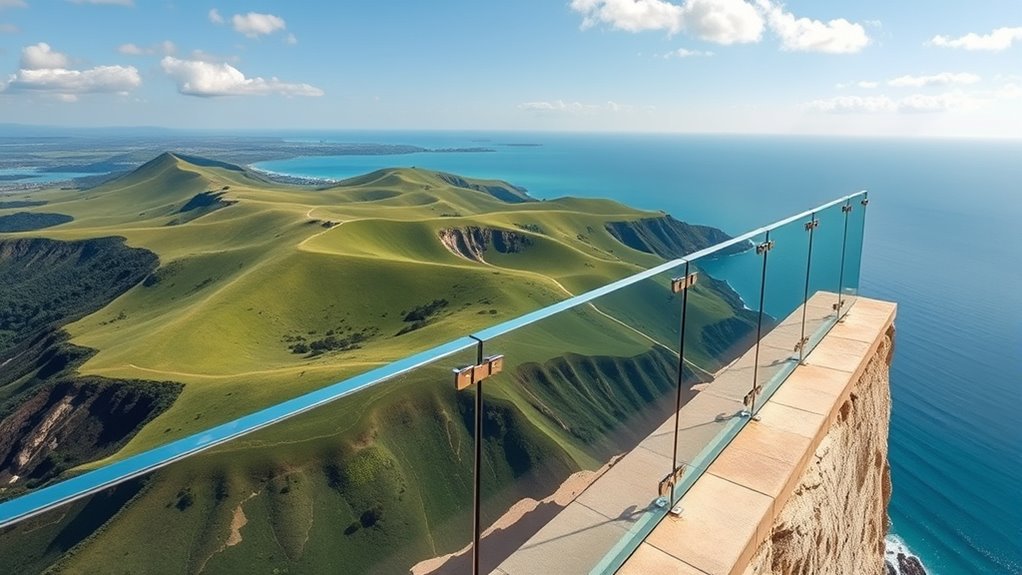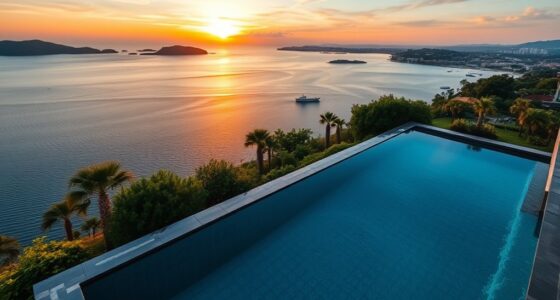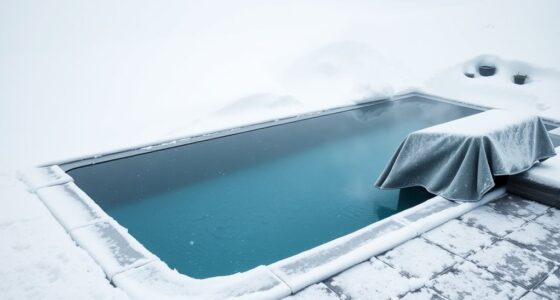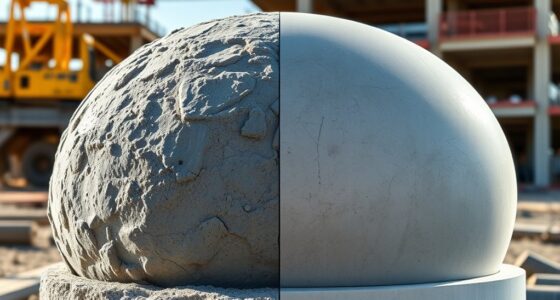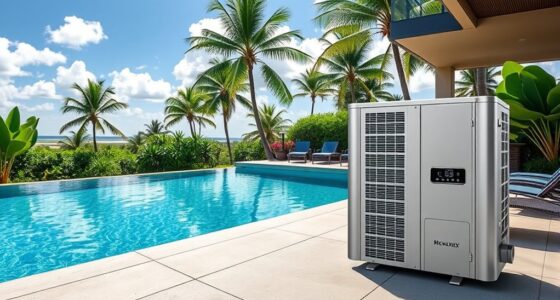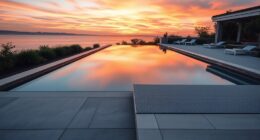To maintain a clear view with your glass balustrade, select high-quality tempered or laminated glass that’s thick enough for safety without compromising transparency. Use minimal or frameless supports, hidden fixings, and slim brackets to keep hardware discreet. Proper installation and support ensure stability while minimizing visual disruption. Regular cleaning preserves clarity, and choosing the right glass treatments can enhance privacy without blocking your view. Keep exploring these tactics to achieve a safe, sleek, and unobstructed design.
Key Takeaways
- Use minimal or frameless supports, such as concealed fixings, to maximize transparency and unobstructed views.
- Select high-quality tempered or laminated glass with slim brackets for strength without visual clutter.
- Incorporate hidden mounting systems and slim hardware to maintain a sleek, seamless appearance.
- Opt for low-height or tinted glass balustrades to balance safety with preserving sightlines.
- Regularly clean and maintain glass surfaces to ensure clarity and aesthetic appeal over time.
Choosing the Right Glass for Maximum Clarity and Safety
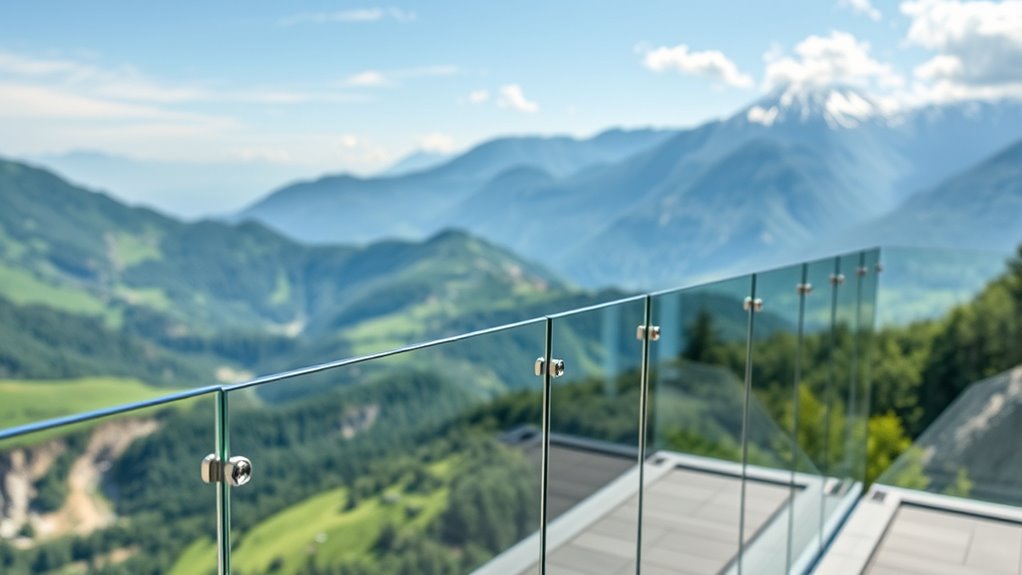
Selecting the appropriate glass for your balustrade is crucial to guarantee both clarity and safety. You want glass that provides a crystal-clear view without sacrificing strength. Tempered glass is your best choice because it’s toughened to withstand impact and resist shattering. Laminated glass, made with a durable interlayer, adds extra safety by holding fragments together if broken. Consider low-iron glass for maximum transparency; it minimizes the greenish tint found in standard glass, ensuring your view remains unobstructed. Always check local safety standards and building codes to ensure compliance. The right combination of glass type, thickness, and treatment ensures your balustrade remains both visually stunning and inherently secure, giving you peace of mind and a flawless view. Additionally, understanding regulatory oversight can help you select materials that meet safety and legal standards.
Optimal Mounting Techniques for Unobstructed Views
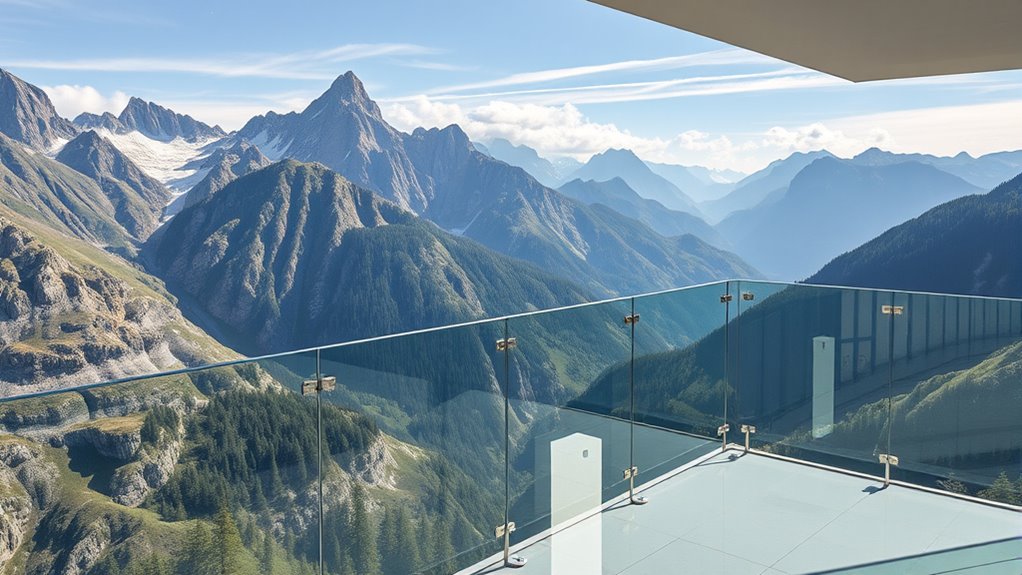
To achieve unobstructed views, you need to focus on hidden fixings strategies that keep the mounting discreet. Frameless glass installation techniques also play a key role in minimizing visual barriers. Additionally, proper spacing and support guarantee stability without compromising clarity. Recognizing angel number patterns can also inspire confidence in choosing the right mounting approach that aligns with your aesthetic and safety goals.
Hidden Fixings Strategies
Hidden fixings are essential for achieving a sleek, unobstructed view with glass balustrades. They eliminate bulky hardware that can distract from the glass’s transparency. To do this effectively, choose mounting systems that conceal fasteners within the structure, such as clamp fixings or surface-mounted brackets with cover caps. These allow the glass to appear seamlessly supported, maintaining a clean aesthetic. Ensure the fixings are corrosion-resistant and compatible with your glass type to guarantee safety and durability. Proper placement is critical—fixings should be positioned to minimize visual impact while providing maximum stability. Using high-quality, discreet fasteners helps you achieve a minimalist look without compromising safety. With these strategies, your balustrade will blend effortlessly into the view, offering both transparency and strength. Additionally, selecting support systems that meet entertainment park safety standards ensures long-term reliability without compromising aesthetic appeal.
Frameless Glass Installation Techniques
Achieving a truly frameless look requires precise installation techniques that prioritize stability without compromising transparency. To do this effectively, focus on these key methods:
- Use minimal mounting hardware: Opt for concealed fixings that are hidden within the glass or structure, ensuring an unobstructed view.
- Select high-strength, thin glass: Thin, laminated glass provides clarity and safety while maintaining a sleek appearance.
- Ensure precise alignment: Measure and install with meticulous care, so each panel fits perfectly, eliminating gaps and wobble.
- Consider contrast ratio in your design: Incorporating high contrast ratios can enhance visual clarity and depth, even in glass structures.
Optimal Spacing and Support
Proper spacing and support are essential for maintaining an unobstructed view while guaranteeing the glass panels stay secure. You should position the panels with enough distance to prevent visual clutter but close enough to provide stability. Typically, support brackets are spaced every 4 to 6 feet, depending on glass thickness and load requirements. Using minimal mounting hardware reduces visual interruption but must still provide adequate reinforcement. Avoid over-tightening fixtures, which can cause stress fractures, and ensure supports are level for a seamless appearance. Properly designed support systems distribute weight evenly, preventing stress points that could compromise safety or clarity. By balancing support with strategic spacing, you preserve an open, transparent aesthetic without sacrificing durability or security.
Incorporating Minimalist Hardware for Sleek Aesthetics
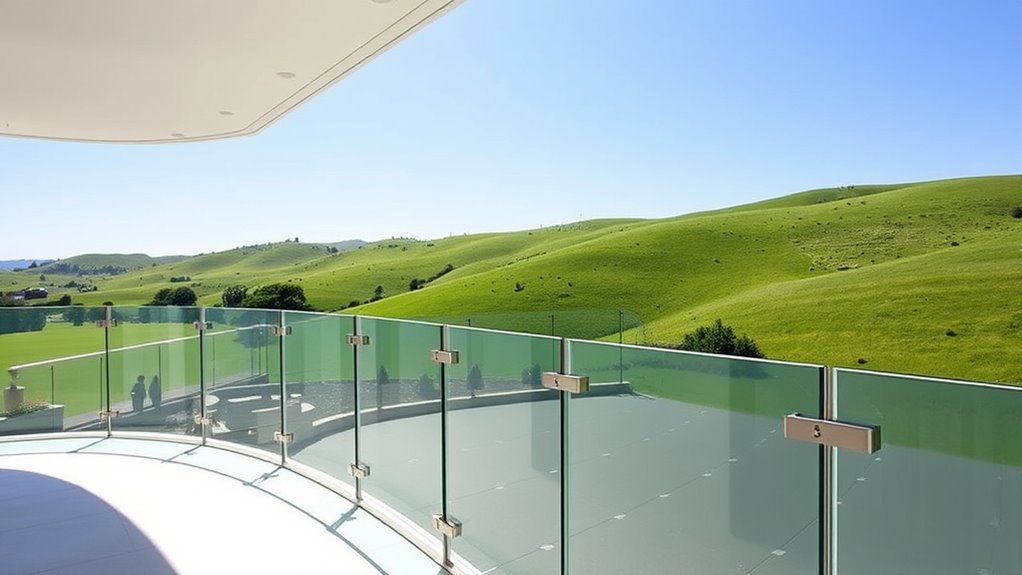
Choosing minimalist hardware can considerably enhance your balustrade’s sleek look by keeping mounting options discreet. Slim profile designs and hidden fastening systems create a seamless appearance that doesn’t distract from your view. By opting for these features, you’ll achieve a modern, unobtrusive aesthetic that complements any space. Additionally, understanding operating hours of local suppliers ensures you can acquire these hardware components promptly and efficiently.
Discreet Mounting Options
To create a sleek, unobtrusive look, opting for minimalist hardware is essential. Discreet mounting options let your glass panels blend seamlessly into your space. Consider these strategies:
- Hidden Brackets: Install brackets behind the glass, so they aren’t visible, maintaining a clean profile.
- Toe-Kick Mounts: Secure the balustrade from below the floor level, making hardware virtually invisible from a viewer’s perspective.
- Floor-Mounted Supports: Use slim, unobtrusive bases that anchor the glass firmly without drawing attention, preserving your view.
These options ensure your balustrade provides safety without sacrificing aesthetics. By choosing discreet mounting methods, you keep the focus on your scenery and design, not hardware.
Slim Profile Designs
Ever wondered how to achieve a sleek, modern look with your glass balustrade? The key lies in slim profile designs that use minimalist hardware. These systems eliminate bulky brackets and heavy fixtures, creating a seamless appearance that highlights the glass itself. You’ll find that narrow clamps and slender posts give your structure a refined, unobtrusive look. This approach not only enhances the aesthetic but also maintains an open, airy feel, perfect for modern homes and commercial spaces. By choosing hardware with slim profiles, you emphasize clean lines and simplicity without sacrificing durability or safety. Incorporating professional-grade fittings ensures that the balustrade remains secure while preserving its sleek appearance. The result is a contemporary, elegant balustrade that blends effortlessly into your environment, allowing your view to stay unobstructed and your design to stand out.
Hidden Fastening Systems
Hidden fastening systems revolutionize glass balustrades by concealing hardware, which creates a sleek, seamless appearance. You’ll achieve a minimalist look that emphasizes clarity and openness. Here’s how these systems enhance your design:
- Clean Aesthetics: No visible screws or brackets distract from the glass’s transparency.
- Ease of Installation: Hidden fixings simplify setup, saving time and reducing errors.
- Durability & Safety: Advanced engineering ensures strong support while maintaining a minimalist profile.
- Understanding self-watering plant pots can help inform the design of discreet support systems, ensuring both functionality and aesthetic appeal.
Balancing Height and Opacity for Enhanced Safety and Sightlines
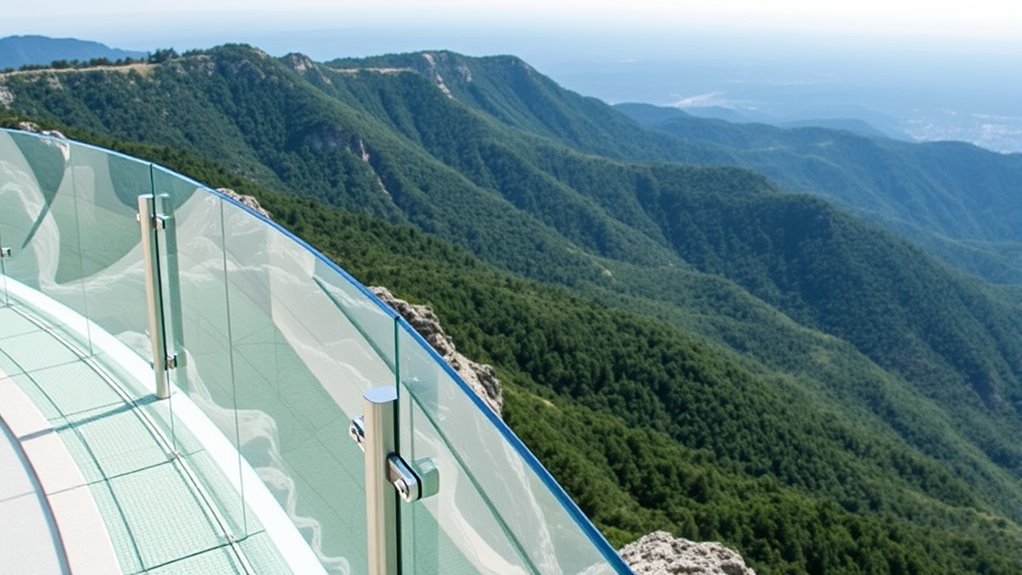
Achieving the right balance between height and opacity in glass balustrades is essential for ensuring both safety and unobstructed sightlines. If the balustrade is too low, it won’t provide adequate protection, risking accidents or falls. Conversely, if it’s too high or opaque, it can block views and detract from the space’s openness. To optimize safety without sacrificing sightlines, consider using tempered or laminated glass at the appropriate height—usually around 42 inches for residential spaces. Adjust opacity through subtle frosting or tinting, which enhances privacy and safety without creating visual barriers. The goal is a design that feels seamless—protective yet transparent enough to maintain the visual connection with your surroundings. Striking this balance enhances both safety and aesthetic appeal. Incorporating regulatory standards ensures your design complies with safety guidelines while maintaining visual clarity.
Utilizing Framing and Support Strategies to Minimize Visual Disruption
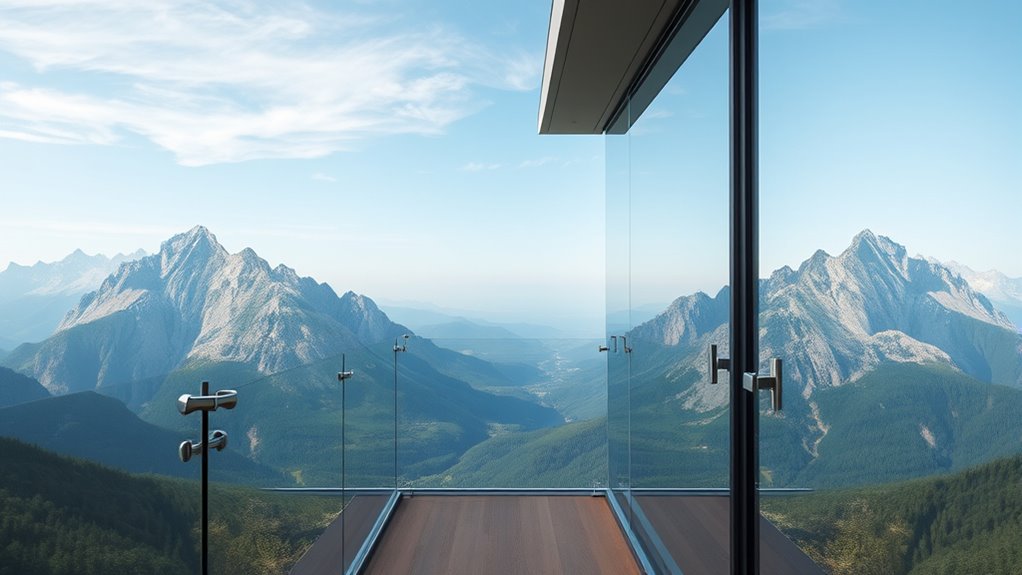
Using smart framing and support strategies plays a key role in maintaining the sleek, transparent look of your glass balustrade. To keep the view unobstructed, consider these approaches:
- Choose minimal or frameless supports to reduce visual clutter.
- Opt for concealed or embedded mounting systems that hide hardware within the structure.
- Use slim, streamlined brackets that blend seamlessly with the glass, drawing attention to the transparency rather than the support.
- Select support materials and designs that are well-maintained and durable to prevent the need for frequent replacements or repairs, ensuring the aesthetic remains clean over time.
Ensuring Structural Integrity Without Compromising Transparency
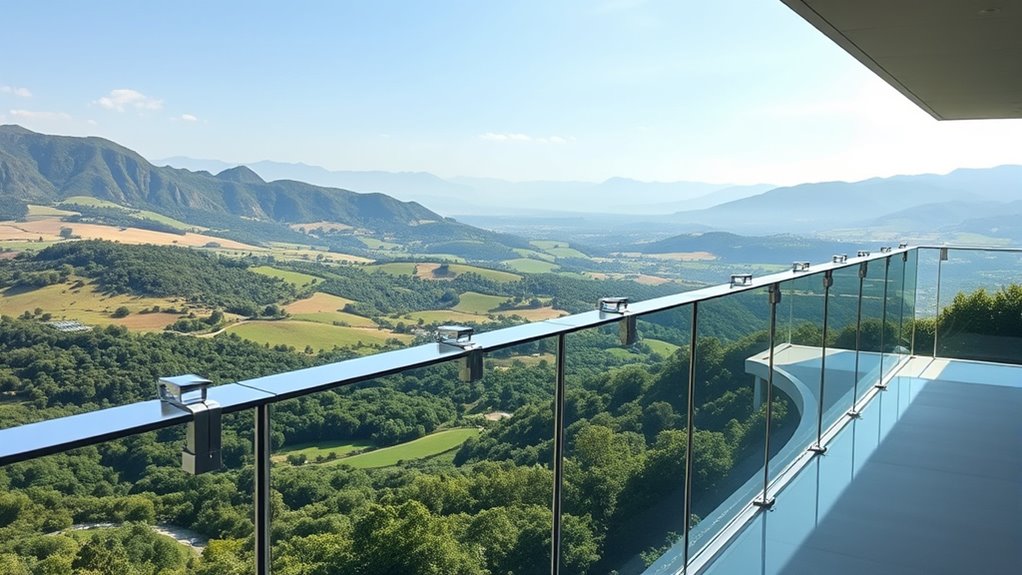
Maintaining the structural integrity of your glass balustrade is essential to guarantee safety and durability without sacrificing its transparent aesthetic. You can achieve this by selecting high-quality tempered or laminated glass, which offers strength and resilience. Proper anchoring and support systems, such as minimal framing or embedded fittings, ensure stability while preserving a clear view. To help you choose the right components, consider this overview:
| Material Type | Strength Level | Suitable Applications |
|---|---|---|
| Tempered Glass | High durability | Balconies, staircases |
| Laminated Glass | Shatter-resistant | Floor-to-ceiling panels |
| Support Fittings | Secure attachment | Frameless designs |
Use these options wisely to balance safety and transparency without compromise. Additionally, understanding the importance of support mechanisms can further enhance the stability and safety of your glass balustrade.
Maintenance Tips to Keep Your Glass Balustrades Clear and Beautiful
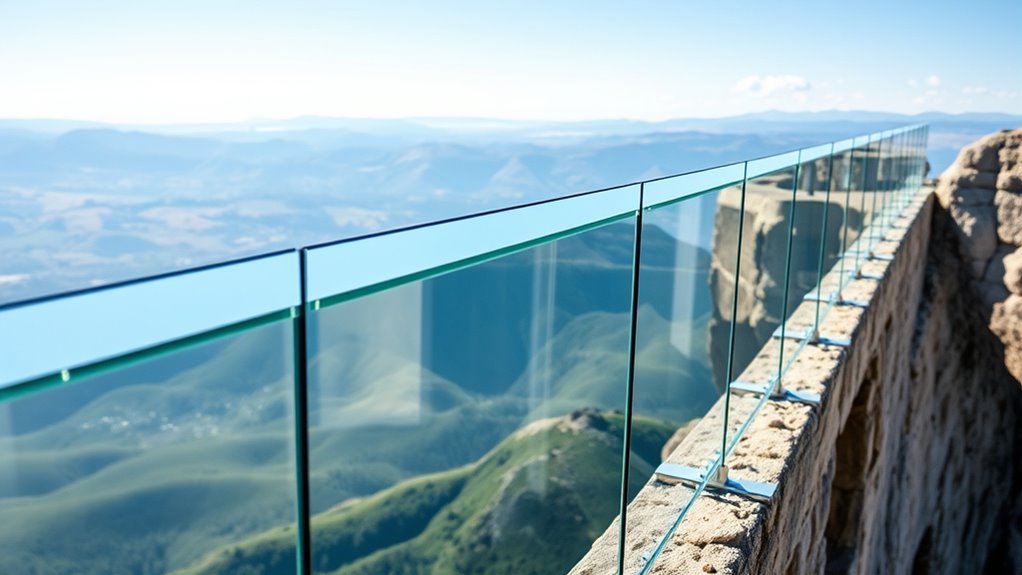
To keep your glass balustrades looking pristine and transparent, regular cleaning is essential. Follow these simple tips to maintain their clarity and beauty:
- Use a soft, lint-free cloth and a glass cleaner or a mixture of water and a few drops of dish soap. Wipe gently to avoid scratches.
- Remove fingerprints and smudges promptly to prevent build-up that dulls the glass.
- Check for dirt and debris in corners and edges, cleaning with a soft brush or cloth to prevent grime accumulation.
Avoid abrasive cleaners or rough scrubbing, which can scratch the surface. Regular maintenance keeps your balustrades sparkling and ensures they remain a stunning feature without compromising safety or transparency.
Frequently Asked Questions
How Do Glass Balustrades Perform in Extreme Weather Conditions?
Glass balustrades perform well in extreme weather conditions when made from tough, tempered, or laminated safety glass. You should guarantee they’re properly installed with sturdy fixtures to withstand strong winds, heavy rain, or snow. Regular maintenance, like cleaning and inspecting for cracks or damage, helps maintain their integrity. With proper selection and care, your glass balustrades will stay durable and safe, even in harsh climates.
Are There Any Legal Restrictions for Glass Balustrades in Certain Areas?
You might think laws are flexible, but some areas have strict glass balustrade regulations. Local building codes often specify glass thickness, safety features, and installation standards to prevent accidents. Ignoring these restrictions could lead to hefty fines or unsafe structures. So, before you install, check with your local authorities. It’s ironic how such fragile-looking glass is subject to rigorous rules—yet safety relies on adhering to them.
What Are the Cost Differences Between Various Glass Types?
You’ll find that the cost varies considerably between glass types. Tempered glass is more affordable, offering strength and safety, while laminated glass costs more due to its layered construction, providing extra durability and sound insulation. Specialty options like tinted or frosted glass also add to the expense. Your choice depends on your budget and aesthetic preferences, but overall, laminated and specialty glasses tend to be at the higher end of the price spectrum.
How Long Do Glass Balustrades Typically Last Before Needing Replacement?
Glass balustrades typically last between 10 to 25 years, depending on factors like quality, installation, and environmental conditions. You can extend their lifespan by choosing high-quality tempered or laminated glass and ensuring proper maintenance, such as regular cleaning and inspections. Harsh weather, especially in coastal areas with salt exposure, may shorten their durability. With proper care, your glass balustrade can stay stunning and safe for many years.
Can Glass Balustrades Be Customized to Fit Unique Architectural Designs?
Absolutely, you can customize glass balustrades to fit your unique architectural vision. You can choose various glass types, shapes, and finishes, and even incorporate intricate designs or patterns. Whether you want sleek modern lines or ornate details, manufacturers can craft solutions that seamlessly blend with your style. This flexibility guarantees your balustrade isn’t just functional but also a stunning focal point, transforming your space into something truly spectacular and one-of-a-kind.
Conclusion
Think of your glass balustrade as the frame of a masterpiece—you want it to enhance the view, not block it. By choosing the right glass, mounting techniques, and support strategies, you create a transparent shield that’s both safe and stunning. Keep it maintained, and it’ll shine like a clear lake reflecting the sky. With these tactics, your view remains unobstructed, a seamless window into the beauty beyond, perfectly balanced and beautifully protected.
